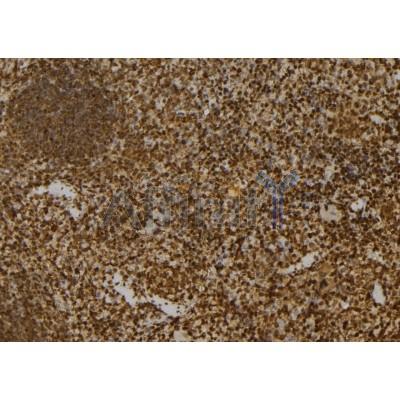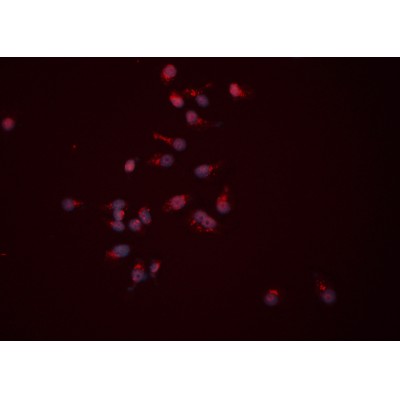产品描述
*The optimal dilutions should be determined by the end user.
*Tips:
WB: 适用于变性蛋白样本的免疫印迹检测. IHC: 适用于组织样本的石蜡(IHC-p)或冰冻(IHC-f)切片样本的免疫组化/荧光检测. IF/ICC: 适用于细胞样本的荧光检测. ELISA(peptide): 适用于抗原肽的ELISA检测.
引用格式: Affinity Biosciences Cat# DF6253, RRID:AB_2838219.
展开/折叠
AP endonuclease 1; AP endonuclease class I; AP lyase; APE 1; APE; APE-1; APEN; APEX 1; APEX; APEX nuclease (multifunctional DNA repair enzyme) 1; Apex nuclease 1; APEX nuclease; APEX1; APEX1_HUMAN; Apurinic endonuclease; Apurinic-apyrimidinic endonuclease 1; Apurinic/apyrimidinic (abasic) endonuclease; Apurinic/apyrimidinic endonuclease 1; Apurinic/apyrimidinic exonuclease; APX; BAP1; Deoxyribonuclease (apurinic or apyrimidinic); DNA (apurinic or apyrimidinic site) lyase; DNA-(apurinic or apyrimidinic site) lyase, mitochondrial; EC 4.2.99.18; HAP 1; HAP1; Human Apurinic endonuclease 1; MGC139790; Multifunctional DNA repair enzyme; Redox factor 1; Redox factor-1; REF 1; REF 1 protein; REF-1; REF1; REF1 protein;
抗原和靶标
- P27695 APEX1_HUMAN:
- Protein BLAST With
- NCBI/
- ExPASy/
- Uniprot
MPKRGKKGAVAEDGDELRTEPEAKKSKTAAKKNDKEAAGEGPALYEDPPDQKTSPSGKPATLKICSWNVDGLRAWIKKKGLDWVKEEAPDILCLQETKCSENKLPAELQELPGLSHQYWSAPSDKEGYSGVGLLSRQCPLKVSYGIGDEEHDQEGRVIVAEFDSFVLVTAYVPNAGRGLVRLEYRQRWDEAFRKFLKGLASRKPLVLCGDLNVAHEEIDLRNPKGNKKNAGFTPQERQGFGELLQAVPLADSFRHLYPNTPYAYTFWTYMMNARSKNVGWRLDYFLLSHSLLPALCDSKIRSKALGSDHCPITLYLAL
种属预测
score>80的预测可信度较高,可尝试用于WB检测。*预测模型主要基于免疫原序列比对,结果仅作参考,不作为质保凭据。
High(score>80) Medium(80>score>50) Low(score<50) No confidence
研究背景
Multifunctional protein that plays a central role in the cellular response to oxidative stress. The two major activities of APEX1 are DNA repair and redox regulation of transcriptional factors. Functions as a apurinic/apyrimidinic (AP) endodeoxyribonuclease in the DNA base excision repair (BER) pathway of DNA lesions induced by oxidative and alkylating agents. Initiates repair of AP sites in DNA by catalyzing hydrolytic incision of the phosphodiester backbone immediately adjacent to the damage, generating a single-strand break with 5'-deoxyribose phosphate and 3'-hydroxyl ends. Does also incise at AP sites in the DNA strand of DNA/RNA hybrids, single-stranded DNA regions of R-loop structures, and single-stranded RNA molecules. Has a 3'-5' exoribonuclease activity on mismatched deoxyribonucleotides at the 3' termini of nicked or gapped DNA molecules during short-patch BER. Possesses a DNA 3' phosphodiesterase activity capable of removing lesions (such as phosphoglycolate) blocking the 3' side of DNA strand breaks. May also play a role in the epigenetic regulation of gene expression by participating in DNA demethylation. Acts as a loading factor for POLB onto non-incised AP sites in DNA and stimulates the 5'-terminal deoxyribose 5'-phosphate (dRp) excision activity of POLB. Plays a role in the protection from granzymes-mediated cellular repair leading to cell death. Also involved in the DNA cleavage step of class switch recombination (CSR). On the other hand, APEX1 also exerts reversible nuclear redox activity to regulate DNA binding affinity and transcriptional activity of transcriptional factors by controlling the redox status of their DNA-binding domain, such as the FOS/JUN AP-1 complex after exposure to IR. Involved in calcium-dependent down-regulation of parathyroid hormone (PTH) expression by binding to negative calcium response elements (nCaREs). Together with HNRNPL or the dimer XRCC5/XRCC6, associates with nCaRE, acting as an activator of transcriptional repression. Stimulates the YBX1-mediated MDR1 promoter activity, when acetylated at Lys-6 and Lys-7, leading to drug resistance. Acts also as an endoribonuclease involved in the control of single-stranded RNA metabolism. Plays a role in regulating MYC mRNA turnover by preferentially cleaving in between UA and CA dinucleotides of the MYC coding region determinant (CRD). In association with NMD1, plays a role in the rRNA quality control process during cell cycle progression. Associates, together with YBX1, on the MDR1 promoter. Together with NPM1, associates with rRNA. Binds DNA and RNA.
Phosphorylated. Phosphorylation by kinase PKC or casein kinase CK2 results in enhanced redox activity that stimulates binding of the FOS/JUN AP-1 complex to its cognate binding site. AP-endodeoxyribonuclease activity is not affected by CK2-mediated phosphorylation. Phosphorylation of Thr-233 by CDK5 reduces AP-endodeoxyribonuclease activity resulting in accumulation of DNA damage and contributing to neuronal death.
Acetylated on Lys-6 and Lys-7. Acetylation is increased by the transcriptional coactivator EP300 acetyltransferase, genotoxic agents like H(2)O(2) and methyl methanesulfonate (MMS). Acetylation increases its binding affinity to the negative calcium response element (nCaRE) DNA promoter. The acetylated form induces a stronger binding of YBX1 to the Y-box sequence in the MDR1 promoter than the unacetylated form. Deacetylated on lysines. Lys-6 and Lys-7 are deacetylated by SIRT1.
Cleaved at Lys-31 by granzyme A to create the mitochondrial form; leading in reduction of binding to DNA, AP endodeoxynuclease activity, redox activation of transcription factors and to enhanced cell death. Cleaved by granzyme K; leading to intracellular ROS accumulation and enhanced cell death after oxidative stress.
Cys-65 and Cys-93 are nitrosylated in response to nitric oxide (NO) and lead to the exposure of the nuclear export signal (NES).
Ubiquitinated by MDM2; leading to translocation to the cytoplasm and proteasomal degradation.
Nucleus. Nucleus>Nucleolus. Nucleus speckle. Endoplasmic reticulum. Cytoplasm.
Note: Detected in the cytoplasm of B-cells stimulated to switch (By similarity). Colocalized with SIRT1 in the nucleus. Colocalized with YBX1 in nuclear speckles after genotoxic stress. Together with OGG1 is recruited to nuclear speckles in UVA-irradiated cells. Colocalized with nucleolin and NPM1 in the nucleolus. Its nucleolar localization is cell cycle dependent and requires active rRNA transcription. Colocalized with calreticulin in the endoplasmic reticulum. Translocation from the nucleus to the cytoplasm is stimulated in presence of nitric oxide (NO) and function in a CRM1-dependent manner, possibly as a consequence of demasking a nuclear export signal (amino acid position 64-80). S-nitrosylation at Cys-93 and Cys-310 regulates its nuclear-cytosolic shuttling. Ubiquitinated form is localized predominantly in the cytoplasm.
Mitochondrion.
Note: The cleaved APEX2 is only detected in mitochondria (By similarity). Translocation from the cytoplasm to the mitochondria is mediated by ROS signaling and cleavage mediated by granzyme A. Tom20-dependent translocated mitochondrial APEX1 level is significantly increased after genotoxic stress.
Monomer. Homodimer; disulfide-linked. Component of the SET complex, composed of at least APEX1, SET, ANP32A, HMGB2, NME1 and TREX1. Associates with the dimer XRCC5/XRCC6 in a DNA-dependent manner. Interacts with SIRT1; the interaction is increased in the context of genotoxic stress. Interacts with HDAC1, HDAC2 and HDAC3; the interactions are not dependent on the APEX1 acetylation status. Interacts with XRCC1; the interaction is induced by SIRT1 and increased with the APEX1 acetylated form. Interacts with NPM1 (via N-terminal domain); the interaction is RNA-dependent and decreases in hydrogen peroxide-damaged cells. Interacts (via N-terminus) with YBX1 (via C-terminus); the interaction is increased in presence of APEX1 acetylated at Lys-6 and Lys-7. Interacts with HNRNPL; the interaction is DNA-dependent. Interacts (via N-terminus) with KPNA1 and KPNA2. Interacts with TXN; the interaction stimulates the FOS/JUN AP-1 complex DNA-binding activity in a redox-dependent manner. Interacts with GZMA, KRT8, MDM2, POLB, PRDX6, PRPF19, RPLP0, TOMM20 and WDR77. Binds to CDK5.
The N-terminus contains the redox activity while the C-terminus exerts the DNA AP-endodeoxyribonuclease activity; both function are independent in their actions. An unconventional mitochondrial targeting sequence (MTS) is harbored within the C-terminus, that appears to be masked by the N-terminal sequence containing the nuclear localization signal (NLS), that probably blocks the interaction between the MTS and Tom proteins.
Belongs to the DNA repair enzymes AP/ExoA family.
研究领域
· Genetic Information Processing > Replication and repair > Base excision repair.
限制条款
产品的规格、报价、验证数据请以官网为准,官网链接:www.affbiotech.com | www.affbiotech.cn(简体中文)| www.affbiotech.jp(日本語)产品的数据信息为Affinity所有,未经授权不得收集Affinity官网数据或资料用于商业用途,对抄袭产品数据的行为我们将保留诉诸法律的权利。
产品相关数据会因产品批次、产品检测情况随时调整,如您已订购该产品,请以订购时随货说明书为准,否则请以官网内容为准,官网内容有改动时恕不另行通知。
Affinity保证所销售产品均经过严格质量检测。如您购买的商品在规定时间内出现问题需要售后时,请您在Affinity官方渠道提交售后申请。产品仅供科学研究使用。不用于诊断和治疗。
产品未经授权不得转售。
Affinity Biosciences将不会对在使用我们的产品时可能发生的专利侵权或其他侵权行为负责。Affinity Biosciences, Affinity Biosciences标志和所有其他商标所有权归Affinity Biosciences LTD.





